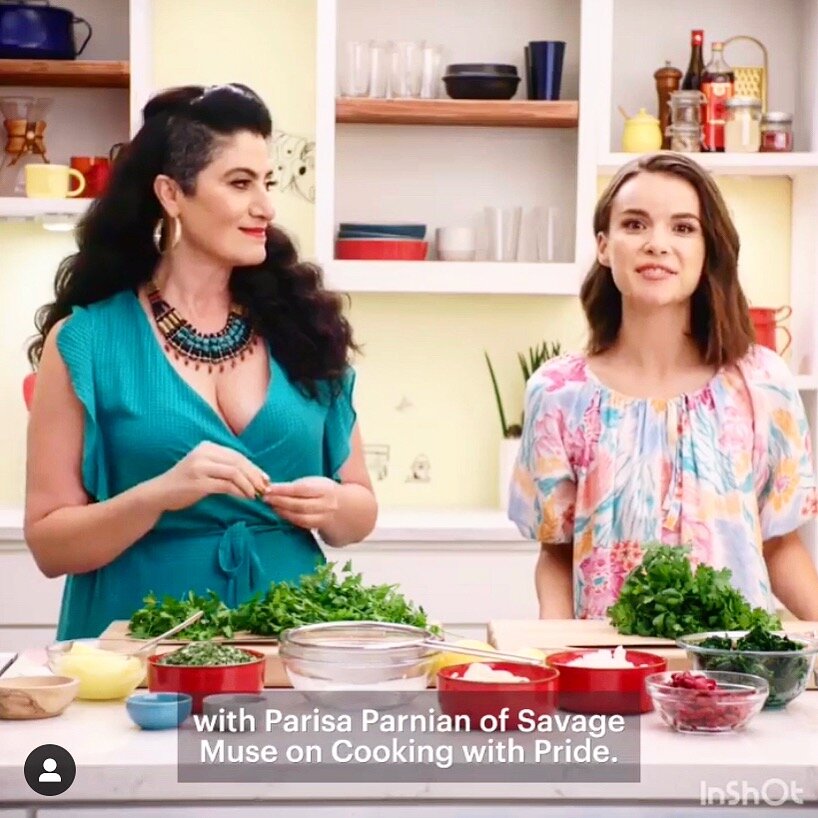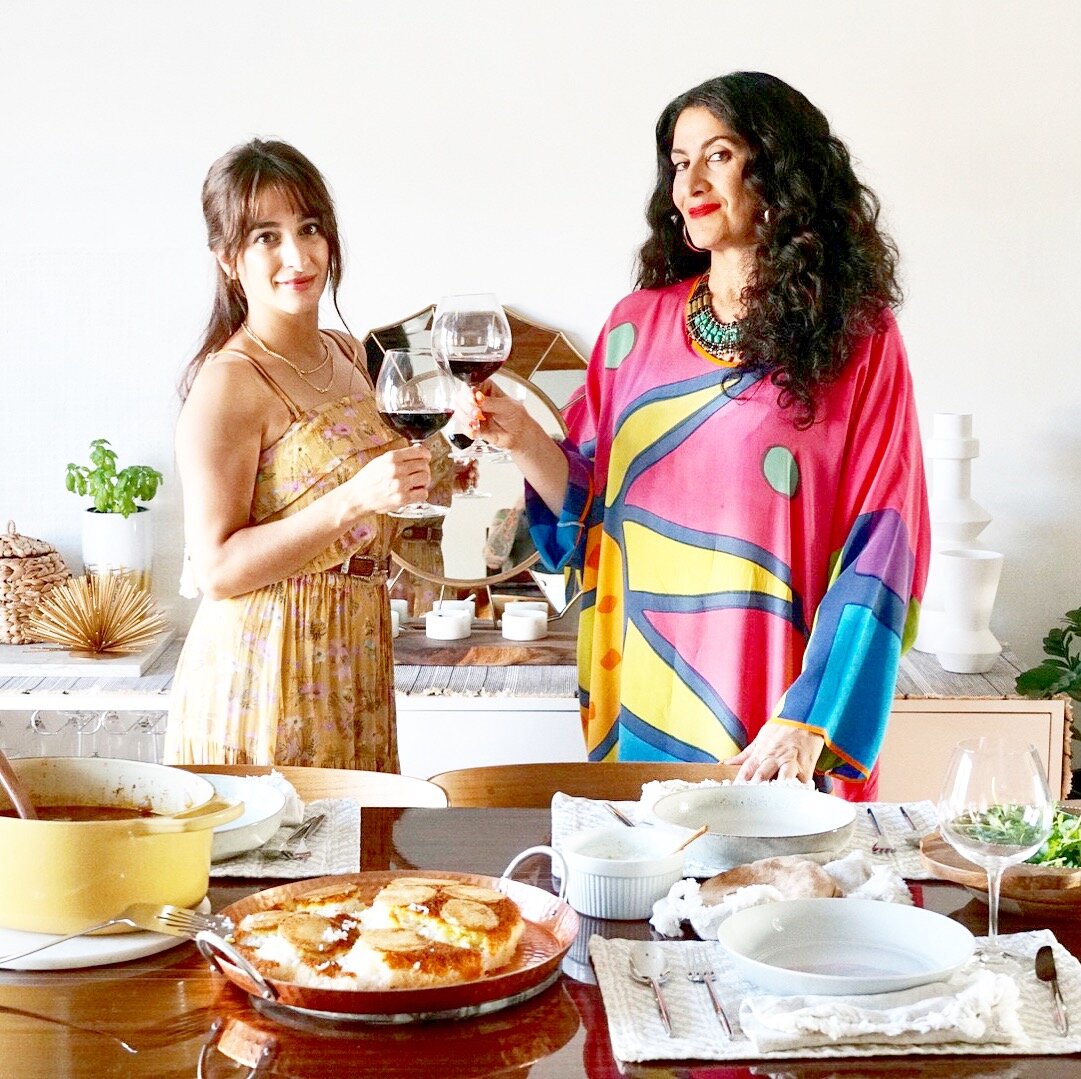COOKING VIDEO: PARISA'S POTATO TAHDIG RICE ON SEVEN SPICE LIFE
Earlier this fall, I had the great pleasure of being a guest on a Seven Spice Life cooking video, showing the secrets to creating the PERFECT crunchy Potato Tahdig Rice. I had been introduced to Lisa Kiorkis, the talented Assyrian-American woman behind Seven Spice Life, last spring— thru a mutual friend who had a hunch we would have a lot in common and hit it off.
We both are first generation Middle-Eastern/SWANA women whose families live in Arizona. Lisa is currently based out of Phoenix, AZ where she is a boss babe entrepreneur who divides her time between the hair salon she runs with her sister and her work on Seven Spice Life. She has quickly become one of my favorite new people and I find her high-energy, passionate, hard-working and stylish vibe to be magnetic.
We had SO MUCH FUN creating this cooking video. I could seriously spend half my days in Lisa’s kitchen, cooking with her while we just chat about all sorts of subjects— from nerding out about cooking techniques to talking about our varied experiences navigating the world as queer middle-eastern women. The other half of my days, I would want to host delicious, fun, and engaging dinner parties and have guest chefs like Lisa bring their flavors, talents and stories to my dinner party guests.
In this cooking video, you can learn not only how to make my signature Potato Tahdig Rice with its perfect crunchy crust but you will also learn how to make Lisa’s quick and delicious Assyrian Chicken Curry Stew that pairs really well with this rice. For my vegetarian and vegan friends, you can create a vegetarian version of the Curry Stew by omitting the chicken, using vegetable stock, and increasing the quantity of vegetables you put in the stew.
I hope you enjoy this video as much as we enjoyed making it! By the time we finished cooking both dishes, the entire house smelled of fragrant and savory aromas and we were both drooling. Shortly after these shots were taken…we sat down and devoured this meal! Yes, we LOVE TO EAT as much as WE LOVE TO COOK!
I really am confident that if you follow the steps and techniques I highlight in the video on how to make the crunchy Tahdig Rice….that you too will get results like this. I would love to hear from you and see pics of your Tahdig Rice experiments.
Email me at: info@savagemuse or thru my IG: @savage_taste and send me pics of your Tahdig dishes!
NOUSHEH JAAN! BON APETITE! EAT WELL AND PROSPER!
The Art of Creating Community Around a Queer Iranian Immigrant's Table.
This past Saturday, I hosted the second installment of a pop-up dinner party series at my home in Los Angeles. I was meeting and greeting all the dinner guests when one of them, who was a friend of a friend, asked me what the purpose of my dinner party was.
That question took me by surprise. I guess I just assumed everyone who had signed up to come to this gathering was looking to have a delicious culinary experience and maybe meet some new people. As I took a minute to gather my thoughts and respond to his question, I had to dig deep and ask myself what exactly the purpose of these dinner parties are.
A photo of me taken before guests began arriving on Saturday....the calm before the (awesome) storm of hostessing a dinner party! Photo credit: Tina June
Although I have made my living for the past 20 years as a fashion/ lifestyle designer and visual artist, cooking and feeding people has been a recurring theme in my life for as long as I can remember. As with many immigrant families, sharing a communal meal of large platters of food has been a part of my upbringing. It is one of the most significant and accessible ways for friends and family to experience a sense of abundance, even during the most difficult of times.
In my early childhood, my parents had lost all their wealth and possessions during the Iranian Revolution and had to start over in Arizona with only their talent and determination. I remember the joy of gathering around the dinner table for large platters of buttery, fluffy basmati rice and slow-cooked braised eggplant to ease and comfort us in our somewhat hostile and foreign environment (where our white Republican neighbors were both suspicious of and slightly fearful of us.)
Khoreshteh Bademjaan (Eggplant Braise) I made for my recent pop-up dinner. Photo credit: Tina June
Later in my young adult life, when I had moved to New York City in the mid 90's to study fashion at Parsons School of Design, I came out to my parents over the phone while stirring a pot of Ghormeh Sabzi to feed a couple of queer Iranian friends who were visiting me from San Francisco.
Ironically, I had been told that when a woman has mastered cooking this national dish, that she was ready for marriage. In my case, mastering Ghormeh Sabzi gave me the courage to come out as queer.
Ghormeh Sabzi (Persian Green Herb Stew) Photo and recipe at: Maman's Kitchen
Breaking bread and sharing the dishes of our motherlands became a big part of the underground queer Arab/Middle-Eastern/Iranian/SWANA scene back in the 90's and early 2000's as well. Long before we had social media to connect us, those of us who were part of these diasporas that had denied our queer/trans existence, were hosting dinner parties and potlucks in our humble apartments and walk-ups in Brooklyn, Queens, San Francisco, Oakland, and many cities in between. We shared stories of both the positive and sometimes devastating effects of our coming out to our respective families, as well as held space for those of us who were still living in the shadows that we called the closet.
Every dinner party starts with "breaking bread"-- in this case, with the delicious sourdough flat bread of Iran called "sangak".
I moved around a bunch in my twenties and thirties for my fashion/design career: from New York to Minneapolis and back to Brooklyn before moving West and spending some time in the Bay Area before making Los Angeles my home seven years ago. Every time I start over in a new town, my first impulse has been to build community by inviting folks over to my home for an authentic Persian/Iranian meal.
One of the dill & fava bean rice dishes I made for last Saturday's dinner. The crust is made with saffron, yogurt and potatoes embedded in the crunchy rice. In Farsi, this is called "Tahdig" which means "bottom of the pot". Photo credit: Tina June
Building community in LA has proven to be a completely different animal than what I have experienced in any other city I have lived in. Folks here are over-scheduled, over-worked, over-committed and have to factor in commutes, parking and geography every time they want to make a social commitment. People tend to congregate mostly with others who work in the same field as they do (read entertainment/movie industry). That organic way in which I have met and built friendships in other towns has proven to be rather ineffective in LaLa Land.
Table setting I designed for the SAVAGE MUSE pop-up dinner series. Pictured on the table are some of the "mezze" style appetizers: Naan'o'Panir (the Persian cheese and herb plate along with Sangak bread). Photo credit: Tina June
For me, creating these SAVAGE MUSE pop-up dinner parties is partly a way to bring together other folks who fall under the intersectional umbrella of mixed cultures, heritages, sexual and gender orientations, occupations and creative interests to come together and break bread together in a visually inviting, comfortable space.
Guests enjoying the "mezze" style appetizers in the outdoor garden area. Photo credit: Tina June
Later in the evening as the guests enjoy the main feast under the mid-summer night sky. Photo credit: Tina June
It is also partly a way for me to more fully express my potential as a lifestyle/brand designer, event creator, visual artist and creative director who can create a seamless brand from the menu design to the social media marketing to the table setting to who I staff and what food I cook and serve. Every aspect of these dinner parties is part of the "Savage Muse" philosophy and aesthetic.
Table setting I designed for the SAVAGE MUSE Pop-Up Dinners. Pattern-mixing, bold colors and textile prints from around the world are essential to the SAVAGE MUSE style. Photo credit: Tina June
The menu I designed for the SAVAGE MUSE Pop-Up Dinner series. I love playing with colors and taking visual design risks!
If you would like to get notified of upcoming SAVAGE MUSE events or read future posts and stories, subscribe to my newsletter at the bottom of this page or click here to send me your contact info. I hope to see you at a future SAVAGE MUSE event!











